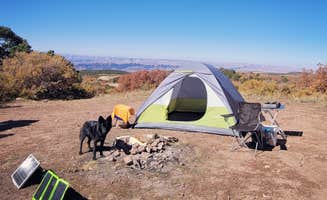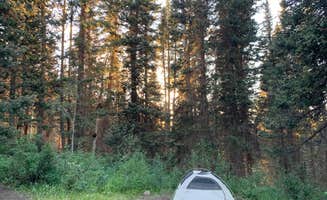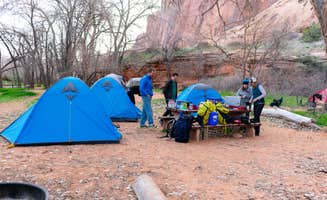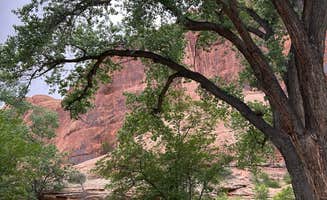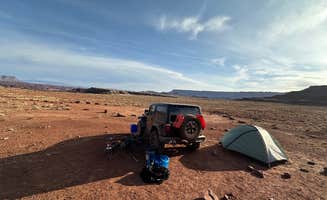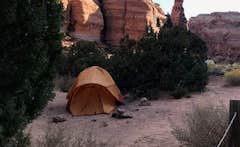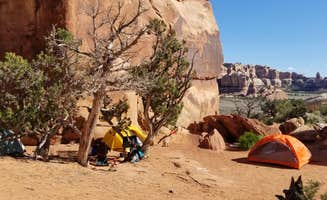Tent campsites near La Sal, Utah range from 4,000 to 9,000 feet in elevation, creating distinct climate zones with temperature differences of up to 30°F between desert floor and mountain locations. During summer months, camping at lower elevations often means daytime highs above 100°F, while higher La Sal Mountain sites maintain more moderate 70-85°F temperatures. Most dispersed camping areas require vehicles to navigate unmarked dirt roads with varying conditions depending on recent rainfall.
What to do
Hiking to Clark Lake: From Oowah Campground, trails lead to additional alpine lakes with moderate difficulty. "We hiked about a 3 mile round trip up to Clarke Lake- which is equally as beautiful and definitely worth a visit," reports one camper. This trail maintains cooler temperatures even during summer months.
Off-road adventures: Gemini Bridges Campground provides direct access to popular 4WD trails. "Awesome campground! The road to get back to this campground can be a little sketch but should be fine if you're in a Jeep or truck," says one reviewer. Many campers use this as a base for day trips exploring surrounding canyon terrain.
Explore ancient petroglyphs: Near Moonflower Canyon Group Site, visitors can view Native American rock art. "Near the mouth of the canyon, early Native Americans carved petroglyphs into the sandstone walls," notes a camper. The area also features a short 0.1-mile hike to a natural amphitheater with a small pond.
What campers like
Year-round accessibility: Behind the Rocks Road Dispersed maintains usable camping conditions through multiple seasons. "For the rest of the week, I moved to another spot a little closer to the entrance, and it was a lot more private. Really recommend this spot if you can snag it," one camper shares about finding better sites away from crowds.
Nighttime tranquility: Higher elevation sites offer exceptional stargazing opportunities with minimal light pollution. "Stars were incredible! About a 50 minute drive from downtown Moab," reports one visitor to Mason's Draw Campground. The distance from urban areas creates ideal conditions for astronomy enthusiasts.
Cellular connectivity: Many camping areas maintain surprisingly good communication access despite remote locations. At Behind the Rocks, a camper notes: "Verizon had 2-3 bars, though, so that was nice at least." Coverage varies significantly by carrier and exact location, with higher ridges typically offering better service than canyon bottoms.
What you should know
Weather precautions: High desert conditions mean rapid temperature changes and potential for sudden storms. "It was windy while we there, and sand blew in through the mesh of our tent, from under the rain fly," reports a Moonflower Canyon camper. Wind gusts of 30+ mph are common, especially during afternoon hours.
Seasonal crowds: Plan arrival times strategically during peak seasons. At Yellow Circle Road Dispersed Camping Area, one visitor found: "We arrived to this area quite at night. There was TONS of space for everyone to comfortably fit. We passed probably 20-30 vehicles camped throughout before we found space for ourselves."
Limited facilities: Most tent camping areas lack basic amenities. "This is a small campground that requires a lot of very winding, steep driving to get to," shares a Rock Castle visitor. Many sites have no water access, requiring campers to bring sufficient supplies for their entire stay.
Tips for camping with families
Urban camping alternative: For families wanting easier access to services, Up the Creek Campground offers amenities within walking distance of town. "Quaint campground two blocks from downtown and a 7-11. Park in the lot and carry your gear (carts provided) to your site. Showers and dish washing area kept up very nicely twice a day," explains one camper.
Wildlife awareness: Children should be educated about local wildlife encounters. "Heard a few bears at night, but that's to be expected," mentions a Rock Castle camper. Sites at higher elevations typically have more wildlife activity, particularly during dawn and dusk hours.
Swimming opportunities: During summer months, select a campsite with water access for family cooling options. A camper at Oowah describes: "The deep, clear, emerald lake is perfect for a quick dip after a hot day." Morning hours typically offer calmer water conditions before afternoon winds develop.
Tips from RVers
Approach routes: RV drivers should carefully select entrance roads to dispersed camping areas. "Using the Northwest entrance initially and had no problem getting to the campsite. Just a few bumps. Using the other entrance, I found too many bumps for my minivan to get over," advises a Yellow Circle Road visitor. Routes change seasonally based on erosion and maintenance.
Spacing considerations: Larger rigs should prioritize sites closer to main access points. "It's a rough road in, the higher up you go on the road, the rougher. We took our travel trailer(22' total) up, just have to be careful," shares another Yellow Circle Road camper. Late arrivals often find better large-vehicle spots already occupied, making midweek, mid-day arrival optimal.



